In this article, You will read Classification of the Indian Rocks i.e. Indian Rock System (Archaean, Purana, Dravidian & Aryan Rock System) – for UPSC IAS.
The geological structure of a country helps in understanding the types and character of rocks and slopes, the physical and chemical properties of soils, the availability of minerals, and the surface and underground water resources.
Indian Rock System
- Geological Structure: Geological structure is most commonly (and best applied ) to the arrangements and deposition of the rocks in the earth’s crust, as a result of (or absence of) earth movements; but also applied to the morphological features (morphology) of rocks; e.g. Gondwana structure.
- Geological Time Scale: Chronological dating of various geological formations (Geological strata) and life according to their time and place of origin, evolution, and extinction. “Giovanni Ardunia developed Geological Time Scale in 1760”. Standard Geological Time Scale developed in International Geological Congress held in 1881, Italy.
- The Indian Geological Time Scale, advocated by T.S. Holland.
- Geological History of India: The Geological Structure & rock systems of India analyzed with reference to their geographical locations and their geological history. The following physiographic divisions of India are used for referencing the geological formations:
- Peninsular India;
- Extra Peninsular India
- Major events in the geological history of India:
- Peninsular India was a part of the old landmass since the formation of the Earth’s Crust
- The upheaval of the Himalayas in the tertiary period.
- Aggradational formation of the Indo-Gangetic plain during the Pleistocene period. It continues till today through sedimentation in the floodplains of the rivers and the lower part of the Gangetic plain.
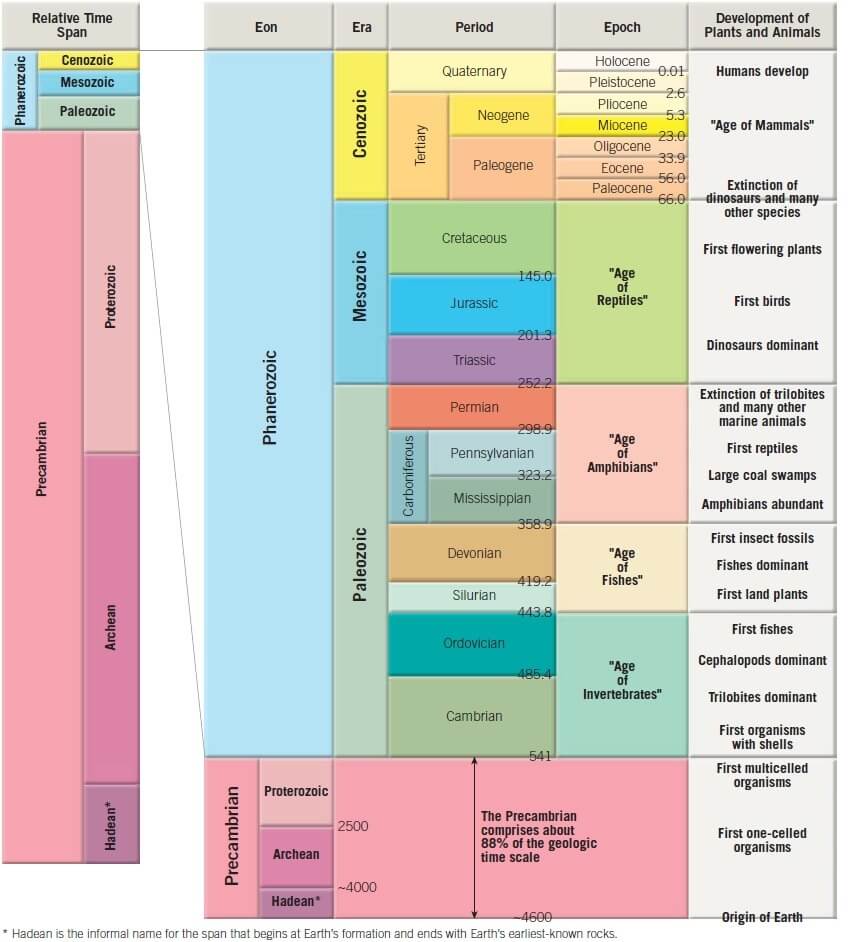
Based on this complex and varied geological history, the Geological Survey of India has classified rock systems of the country into 4 major divisions:
- The Archaean Rock System
- The Purana Rock System
- The Dravidian Rock System
- The Aryan Rock System
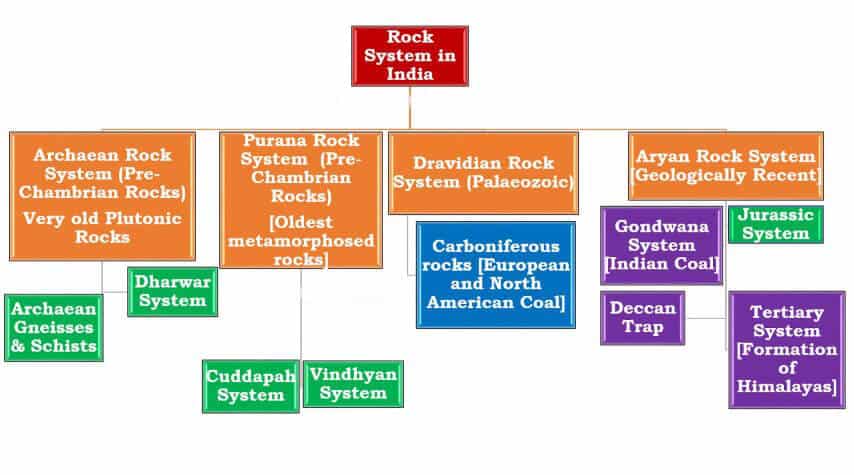
Archaean Rock System (Pre-Cambrian Rocks)
- The earliest phase of tectonic evolution was marked by the cooling and solidification of the upper crust of the earth’s surface in the Archaean era (prior to 2.5 billion years; Precambrian Period) which is represented by the exposure of gneisses and granites, especially on the Peninsula.
- These form the core of the Indian Craton (Block of Indian Subcontinent of Gondwanaland).
- The term ‘Archaean’ introduced by J.D. Dana in 1782, refers to the oldest rocks of the earth’s crust.
- The Archaean group of rocks consists of two systems-
- (a) Achaean System: Granites and Gneisses,
- (b) Dharwar System: First Sedimentary Rocks
Gneiss — Mineral composition varies from granite to gabbro.
Schists — mostly crystalline, include mica, talc, hornblende, chlorite, etc.
Archaean Gneisses and Schists
These rocks are:
- Oldest rocks [pre-Cambrian era] [formed about 4 billion years ago].
- Rocks formed due to the solidification of molten magma – the earth’s surface was very hot then.
- Known as the ‘Basement Complex’ [They are the oldest and forms the base for new layers]
- Azoic or unfossiliferous,
- Foliated (consisting of thin sheets),
- Thoroughly crystalline (because they are volcanic in origin),
- Plutonic intrusions (volcanic rocks found deep inside).
Dharwar System
- Formation period ranges from 4 billion years ago to – 1 billion years ago.
- Highly metamorphosed sedimentary rock-system. [formed due to metamorphosis of sediments of Archaean gneisses and schists].
- They are the oldest metamorphosed rocks.
- Found in abundance in the Dharwar district of Karnataka.
- Economically the most important rocks because they possess valuable minerals like high-grade iron-ore, manganese, copper, lead, gold, etc.
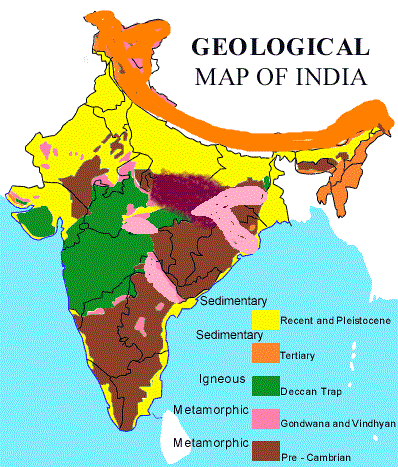
Purana Rock System
- The Cuddapah and Vindhyan rock systems are together known as the Purana rock system.
- They are formed by the erosion and deposition of Archean and Dharwar rocks, the process is believed to have taken place between 1400-600 million years ago.
- They are mostly sedimentary in nature.
Cuddapah System
- Named after the Cuddapah district of Andhra Pradesh, due to the large development of outcrops of cudappah rocks
- They were formed when sedimentary rocks like sandstone, limestone etc., and clay were deposited in synclinal folds (between two mountain ranges).
- Outcrops best observed in Cuddapah district of Andhra Pradesh.
- These rocks contain ores of iron, manganese, copper, cobalt, nickel, etc.
- They contain large deposits of cement grade limestones.
Vindhyan System (1300-600 million years)
- This system derives its name from the great Vindhyan mountains.
- The system comprises of ancient sedimentary rocks (4000 m thick) superimposed on the Archaean base.
- Mostly Unfossiliferous rocks and a large area of this belt is covered by the Deccan trap.
- The Vindhayan system have diamond-bearing regions from which Panna and Golconda diamonds have been mined.
- It is devoid of metalliferous minerals but provides large quantities of durable stones, ornamental stones, limestone, pure glass making sand, etc.
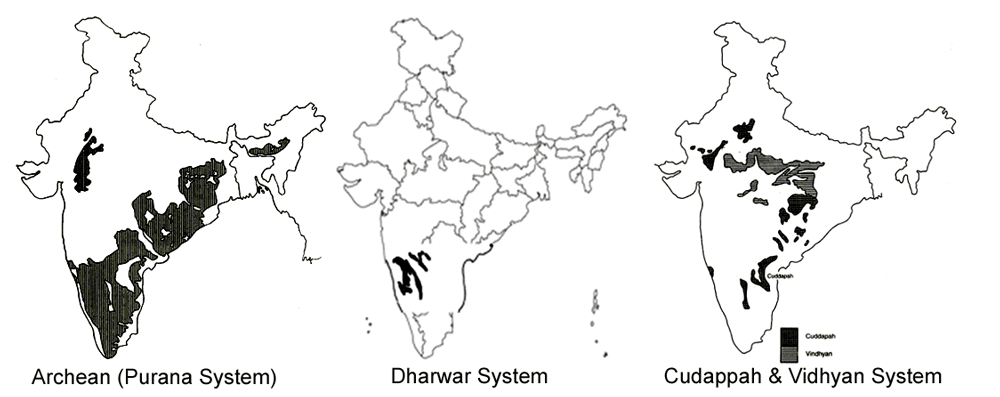
Dravidian Rock System (Palaeozoic)
- The Paleozoic rock formation is known as Dravidian systems in India; during the Paleozoic era i.e., 600-300 million years ago. It is also known as the Carboniferous rocks System due to high-quality Coal formation in the World.
- These rocks are mostly found in the extra-Peninsular regions of the Himalayas and the Gangetic plain and are very little in the Peninsular shield (Umaria in Rewa).
- PirPanjal, Handwara, Lider valley, Annatnag of Kashmir, Spiti, Kangra & Shimla region of Himanchal Pradesh Gharwal & Kumayun of Uttarakhand are the major region of Dravidian rocks.
- The Dravidian rocks mainly include shales, sandstones, clays, quartzites, slates, salts, talc, dolomite, marble, etc.
- It is the period when Pangaea was broken and the Tethys Sea came into existence.
- It marks the beginning of life on the earth’s surface. The rocks of this is the period saw plenty of fossil evidences.
- These are seen in all geological formations from this period. They also indicated marine conditions in these Paleozoic rocks in India.
- The Dravidian period was the beginning of coal formation ((high-Quality Carboniferous coal) but these formations were not found abundantly in India.
- The Dravidian system of geological formations includes the rocks of the following geological ages:
- The Cambrian System;
- The Ordovician Systems;
- The Silurian System;
- The Devonian System (fossils & corals) &
- The Carboniferous Systems (Lower & Middle Carboniferous system).
Carboniferous rocks (350 million years)
- The Carboniferous rocks (350 million years) comprise mainly of limestone, shale, and quartzite.
- Mount Everest is composed of Upper Carboniferous limestones.
- Coal formation started in the Carboniferous age.
- Carboniferous in geology means coal-bearing. [most of the coal found in India is not of the Carboniferous period; High-quality coal of Great Lakes Region-USA, U.K and Ruhr region is Carboniferous coal].
Aryan Rock System
- The beginning of the Upper Carboniferous period is known as the Aryan Group, has come to the threshold of the last, longest, and most eventful era, extending from Upper Carboniferous to the Holocene period.
- The Aryan Group of Rock Formation classified in the following Group:
- Upper Paleozoic Era—- Upper Primary Epoch– Upper Carboniferous & Permian Period formation
- Mesozoic Era-—Secondary Epoch -Triassic, Jurassic & Cretaceous period Formation(Gondwana Rock system, Deccan trap, Jurassic system)
- Cenozoic Era-—Tertiary Epoch – Paleocene, Eocene, Oligocene-Miocene & Pliocene Period
- Neozoic Era— Quaternary Epoch– Pleistocene & Holocene/recent Period.
Gondwana System
- The Gondwana System [derives its name Gonds, the most primitive people of Telangana and Andhra Pradesh]
- They are deposits laid down in synclinal troughs on ancient plateau surface.
- As the sediments accumulated, the loaded troughs subsided.
- Fresh water and sediments accumulated in these trough and terrestrial plants and animals thrived.
- This happened since Permian period (250 million years ago).
Gondwana Coal
- Gondwana rocks contain nearly 98 per cent of India’s coal reserves.
- Gondwana coal is much younger than the Carboniferous coal and hence it’s carbon content is low.
- They have rich deposits of iron ore, copper, uranium and antimony also.
- Sandstones, slates and conglomerates are used as building materials.
Jurassic System
- The marine transgression in the latter part of the Jurassic gave rise to thick series of shallow water deposits in Rajasthan and in Kuchchh.
- Coral limestone, sandstone, conglomerates and shales occur in Kuchchh.
- Another transgression on the east coast of the Peninsula is found between Guntur and Rajahmundry.
Deccan Trap
- Volcanic outburst over a vast area of the Peninsular India from the end of the Cretaceous till the beginning of the Eocene gave rise to Deccan Traps.
- Basaltic lava flowed out of fissures covering a vast area of about ten lakh sq km.
- These volcanic deposits have flat top and steep sides and therefore called ‘trap’ meaning a ‘stair’ or ‘step’ in Swedish.
- The process of weathering and erosion (denudation) since millions of years has reduced the Deccan Trap to almost half of its original size.
- Present Deccan Trap covers about 5 lakh sq km mainly in parts of Kuchchh, Saurashtra, Maharashtra, the Malwa plateau and northern Karnataka.
- Thickness of the Deccan Traps is 3,000 metres along the west which is reduced to 600-800 metres towards the south, 800 metres in Kuchchh and only 150 metres at the eastern limit.
- The weathering of these rocks for a long time has given birth to black cotton soil known as ‘regur’.
The Deccan Trap has been divided into three groups:
| Group | Found in | Inter-trappean beds | Layers of volcanic ash |
| The Upper Trap | Maharashtra and Saurashtra | Present | Present |
| The Middle Trap | Central India and Malwa | Very rare to absent | Present |
| The Lower Trap | Present | Very rare to absent |
Tertiary System
- Eocene to Pliocene about 60 to 7 million years ago. Characterized by two events- the final breaking up the old Gondwana land and the upliftment of Tethys geosynclines or Himalayas.
- The tertiary is the most significant period in India’s geological history because the Himalayas were born and India’s present form came into being in this period.
- The Tertiary Succession are fully spread over the Bengal and Ganges delta, East coast, and the Andaman Islands. They are also found in the Salt Range, Potwar Plateau, outer Himalayan regions of Jammu and Punjab, Assam, Sind, and Baluchistan. Important rock systems include Karewas of Kashmir, Bhangra, and Khadar of the Gangetic plains, etc.
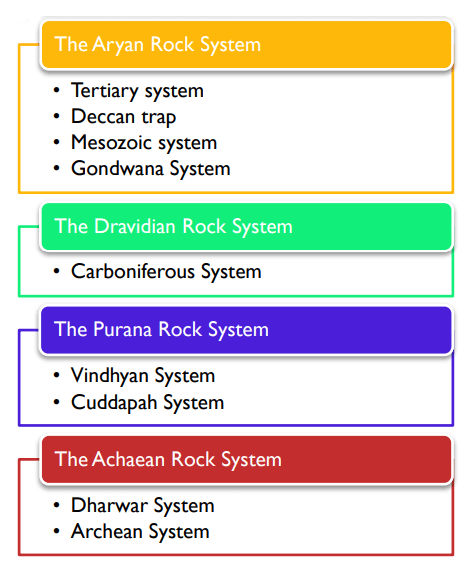
The geology history of India saw unique and diverse character. Different regions of India contain rocks belonging to different geologic periods. The Indian Craton was once part of the supercontinent of Pangaea.
After the breaking of the Gondwanaland carton (225 my ago) and sliding towards the Eurasian craton, the Himalayan mountain region came into existence (65 my ago).
After a succession of Outer Himalayas wide spared alluvial plain formation began in upper Pliocene & Pleistocene period as the Indo- Ganga- Brahmaputra plain region. Thus different parts of India contain rocks of almost every type of geological structure of different geologic periods.
The stratigraphy of India can be divided into several divisions such as Archean System, Dharwar System, Cudappah system, Vindhyan system, Dravidian system, and Aryan system (Gondwana, Jurassic, Deccan Trap, Tertiary and Quaternary rocks).
India is marked by the oldest rocks to the newest alluvial formations, found in the these geological stratum of India. The oldest rocks of the Archaean period are found in peninsular India. Sedimentary rocks are found in the land formed by the deposition of sediments from the Indo- Gangetic plains. Different sedimentary and metamorphism rocks also trace in the Great folded mountainous region.
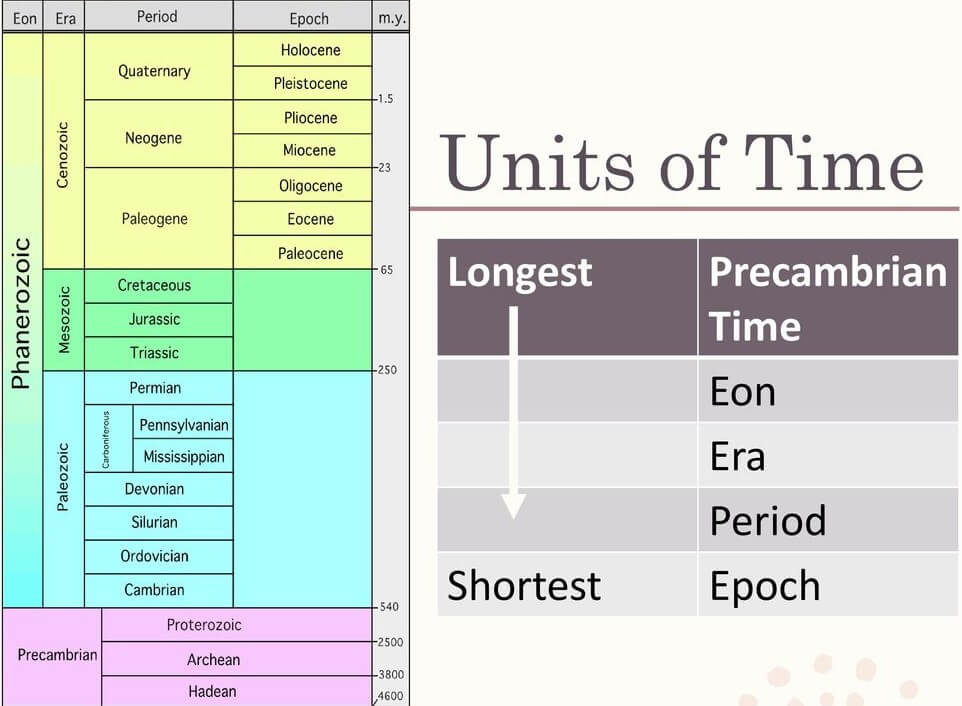

its really helpful thankyou for providing it
hatsoff for the team ….extremely gratefull
Thanks for valuable feedback, Your comments motivate me to do a lot for you guys!
wowwowowowwowo
Yse
Thanks
Amazing content especially for geography. Gem you are
Unbelievable notes for upsc ((preliminary and,mains examination)) thanks for the notes sir.
wel explanation
Enough for upsc?
can i relly on it only
Yeah , definitely 👍
Well explained, Sir
I tried to find the best explanation on this topic and finally found it .just woow, everything is covered superbly.
sir i m from a very middle class family who cannot afford expensive coachings this site helped me a lot ,god bless u sir.
good job from lotusarise team its a very confusing and ignored topic but made easier for us thank u
really love this explanation